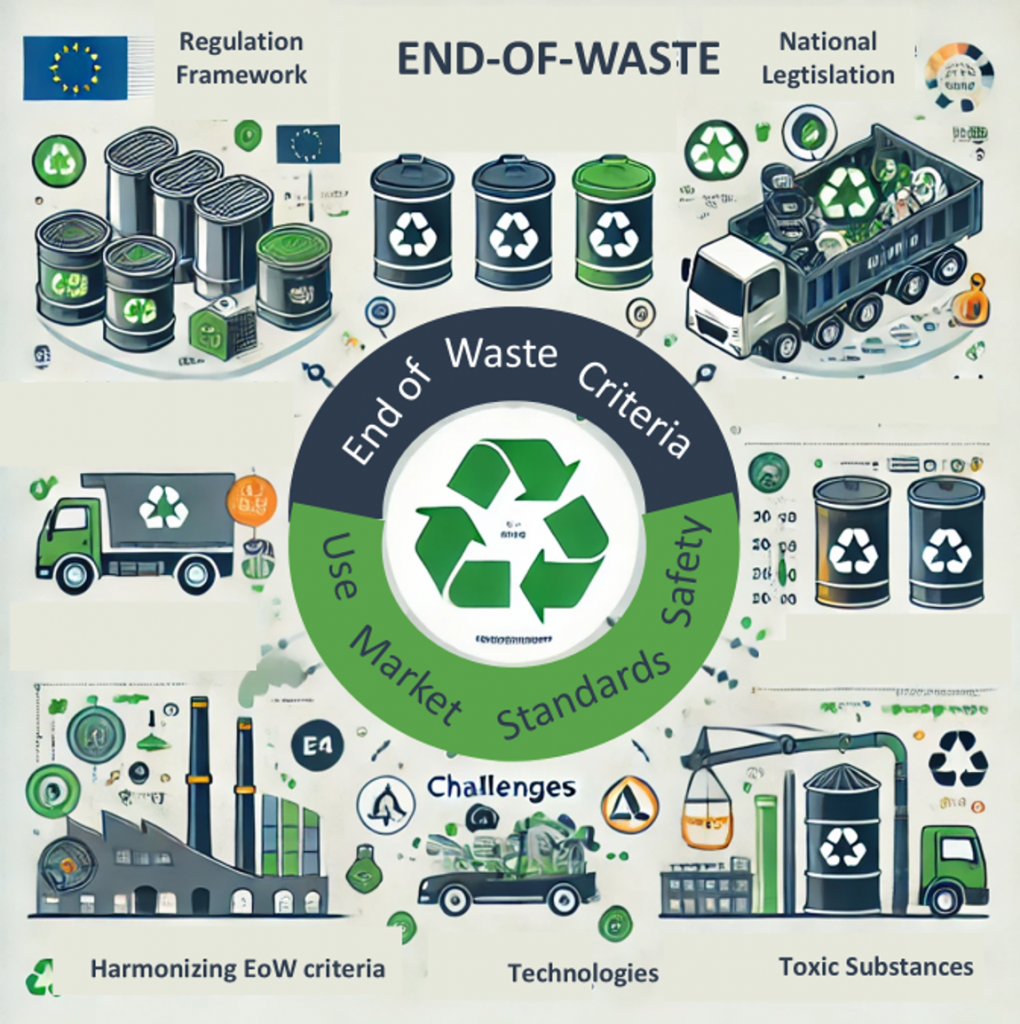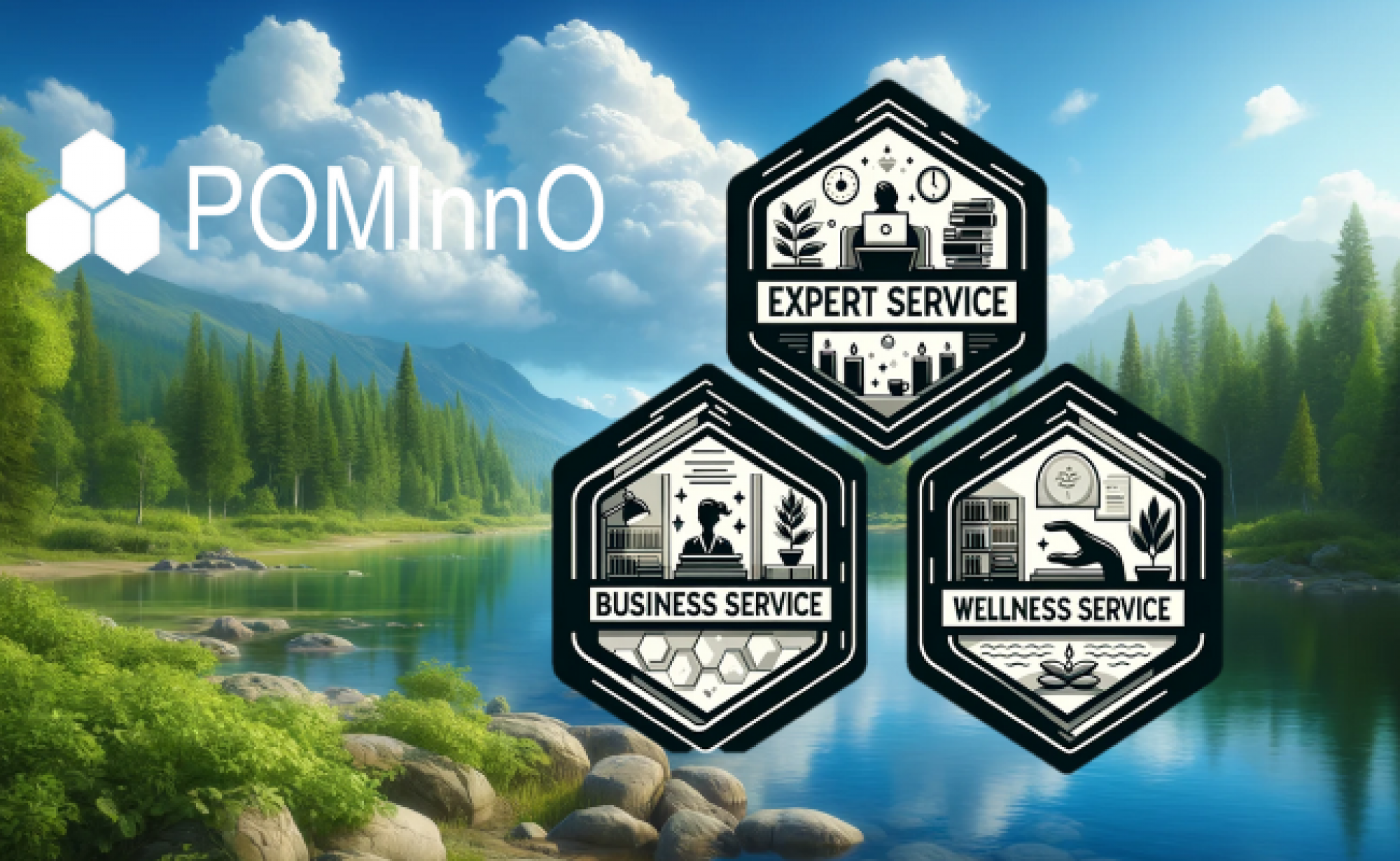
The End-of-Waste Criteria (EoW) represent a crucial regulatory element in the European Union’s (EU) waste management framework. Their purpose is to ensure that materials that cease to be considered waste meet certain quality and safety standards, essential for promoting the circular economy. A review of the literature in this area offers insights into the mechanisms behind the implementation of these criteria and the challenges associated with their practical application.
- Regulatory Framework and Implementation Principles
Numerous publications address the regulatory frameworks related to EoW conditions. The main reference point is the Waste Framework Directive 2008/98/EC, which defines the core principles of waste management in the EU, including EoW criteria. Works such as the European Commission’s White Paper (2011) and commentary on this directive emphasize the importance of these regulations in promoting recycling and minimizing waste disposal. In Polish legislation, the issue of End-of-Waste is covered in Chapter 5 of Part I of the Waste Act.
According to legal frameworks (Waste Framework Directive 2008/98/EC) and literature (Delgado Sancho et al, 2009), the core of the EoW system is four general conditions that must be met for a material to no longer be considered waste:- Material Use – The material must be commonly used for specific purposes, similar to other market materials. This means that the material, which has lost its waste status, should have a real and practical use recognized in the economy (according to Art. 14 Sec. 1. 1) a) of the Waste Act: “the object or substance is to be used for specific purposes”).
- Existence of a Market or Demand for the Material – There must be a market or demand for the material, ensuring that it will not be treated as waste again. The material should have commercial value, and its recipients must be able to purchase or reuse it in compliance with regulations (according to Art. 14 Sec. 1. 1) b) of the Waste Act: “there is a market for such objects or substances or demand for them”).
- Meeting Technical and Legal Standards – The material, which ceases to be considered waste, must meet certain technical standards and legal requirements related to quality and safety, to be used without adverse effects on the environment or public health (according to Art. 14 Sec. 1. 1) c) of the Waste Act: “the object or substance meets the technical requirements for use for specific purposes and the requirements specified in the regulations, in particular concerning chemicals and products applicable to that object or substance, and in the applicable product standards”).
- No Harm to the Environment or Health – The material must undergo a recovery or recycling process, and its further use should not pose a threat to the environment or human health. This includes control over hazardous substances and potential contaminants that may be present in the waste (according to Art. 14 Sec. 1. 1) d) of the Waste Act: “the use of the object or substance does not lead to negative consequences for human life, health, or the environment”).
- National Differences in Implementing EoW Criteria
The previous chapter addressed the general conditions that need to be met in order to achieve EoW status. The revised Waste Framework Directive (WFD) includes a provision by which certain specified waste shall cease to be waste when it has undergone a recovery operation and complies with specific criteria developed in accordance with a number of conditions. Those detailed criteria shall ensure a high level of protection of the environment and human health and facilitate the prudent and rational utilisation of natural resources. They shall include:
- permissible waste input material for the recovery operation;
- allowed treatment processes and techniques;
- quality criteria for end-of-waste materials resulting from the recovery operation in line with the applicable product standards, including limit values for pollutants where necessary;
- requirements for management systems to demonstrate compliance with the end-of-waste criteria, including for quality control and self-monitoring, and accreditation, where appropriate; and
- a requirement for a statement of conformity.
At EU level we have several waste stream, for which the EoW criteria have been developed. These are: a) iron, steel and aluminium scrap (see Council Regulation (EU) N° 333/2011); b) glass cullet (see Commission Regulation (EU) N° 1179/2012), c) copper scrap (see Commission Regulation (EU) N° 715/2013). Recently, stakeholders and policymakers have been calling for identification of further possible material streams for which to develop end-of-waste criteria. JRC has started developing new scientific proposals for end-of-waste criteria for plastics and plans to do the same for textiles.
- In addition, some publications, such as López-Portillo et al. (2021) and COM (2023), highlight national differences in the implementation of directives and the challenges of harmonizing these regulations across EU member states. Despite the common EU framework, the implementation of EoW criteria varies between member states. Harmonizing these regulations faces challenges, particularly due to differences in infrastructure, technological resources, the development level of waste management, and national regulations in individual countries.
- Differences in Recycling Infrastructure: Some countries, especially those with more advanced waste management systems, have better-developed recycling infrastructure, allowing for more effective implementation of EoW criteria. For example, countries like Germany or the Netherlands have advanced sorting, separation, and processing systems that facilitate control over the quality of materials obtained from recycling. On the other hand, in countries with less developed infrastructure (e.g., some Central and Eastern European countries, including Poland), limited availability of technology and investment in the recycling sector may hinder the fulfillment of these criteria.
- Different Regulatory Approaches: The introduction of EoW in some countries may be more restrictive than in others, depending on national regulations concerning environmental protection and public health. COM (2023) indicates that countries such as Denmark or Sweden apply stricter standards for recycling and waste processing, which increases the certainty that materials that cease to be considered waste are safe for the environment and health. Meanwhile, in other countries, where regulations may be less stringent, there is a risk that materials that formally meet EoW criteria may contain hazardous substances or not meet the appropriate quality standards.
- Harmonizing Regulations: One of the key challenges authors highlight is the need for harmonizing regulations across the EU. López-Portillo et al. (2021) points out that differences in the approach to implementing EoW criteria may lead to problems in the EU’s internal market, where materials considered non-waste in one country may be treated differently in other member states. This, in turn, may lead to issues related to the trade of secondary materials and their cross-border flow.
- Challenges of Harmonizing EoW
The harmonization of EoW faces several challenges, which include:- Technological Issues: Differences in waste processing and recycling technology can make it difficult to ensure uniform quality standards for recovered materials in different countries. Countries with more advanced technologies may implement EoW regulations more quickly and effectively.
- Regulations on Hazardous Substances: There could be differences at national level whether wastes are classified as hazardous or not. This can, in consequence impact how waste is treated and which materials can achieve non-waste status. COM (2023) notes that varying standards for chemicals may cause materials considered safe in one country not to meet the standards in another.
- Management of Transboundary Waste: The flow of waste and secondary materials between EU member states presents an additional challenge. Problems may arise when materials considered non-waste in one country are transported to another, where regulations may be more restrictive. The need to adapt to different standards and regulations in individual countries complicates the creation of a single market for secondary materials.
- The
Importance of a Circular Economy
Literature on EoW criteria often links them to the concept of the circular economy (CE). Studies such as Renfors (2024) and Geissdoerfer et al. (2017) analyze how EoW integrates into broader efforts to reduce the use of primary raw materials and promote recycling. Authors emphasize that effective implementation of EoW can contribute to reducing pressure on natural resources and cutting CO₂ emissions, which directly relates to the achievement of the EU’s climate goals.
- Challenges
with Hazardous Substances
One of the main concerns raised in the literature on EoW criteria is the presence of hazardous substances in recycled materials. Articles such as Pivnenko & Astrup (2016) and Xu Pan (2022) highlight that chemical contaminants, including hazardous substances, can hinder the recycling and reuse process. Authors suggest that effective identification and elimination of these substances before the material is deemed “non-waste” is crucial for ensuring environmental and health safety.
- Implementation in Poland
Poland, as an EU member, implements EoW criteria according to EU regulations, though the literature on how these principles function in the Polish context is limited. Hryb and Ceglarz (2021) and IOŚ-PIB (2021) analyze the implementation of the Waste Framework Directive in Poland, pointing out issues related to recycling infrastructure, law enforcement, and low public awareness regarding the circular economy. The literature also emphasizes challenges related to the control and monitoring of materials deemed to meet EoW criteria, particularly in the context of hazardous waste. Several authors suggested that the EoW regulation in Poland will be an empty provision, without a significant impact on waste management practices (den Boer et al., 2017). Recently, additional EoW criteria have been developed in Poland for asphalt rubble waste (MCE, 2021) and waste generated in the process of energy combustion of fuels (MCE, 2022).
- Future
Challenges and Perspectives
The literature on the future of EoW criteria and their role in the circular economy highlights the need for further harmonization of regulations within the EU and the improvement of recycling-related technologies. Hahladakis and Iacovidou (2018) suggest that modern technologies, such as automatic waste sorting and better material processing techniques, could contribute to more effective implementation of EoW criteria.
Summary/Conclusions
The End-of-Waste Criteria are an essential tool in promoting sustainable
development and the circular economy. A key element of effective implementation
of EoW criteria is the harmonization of regulations within the EU. The
literature and experiences indicate key challenges, such as managing hazardous
substances and differences in the implementation of regulations across various
EU countries, including Poland. Despite these difficulties, further
harmonization of regulations and the development of technology may contribute
to the more efficient realization of these principles in the future.
This and other issues are being discussed in the Life Fit for Reach 2 project. Would You like to find out how our project can help You with REACH – fill in the form and we will contact You shortly.
Bibliografia:
- Geissdoerfer, Martin, Paulo Savaget, Nancy M.P. Bocken, i Erik Jan Hultink. 2017. “The Circular Economy – A New Sustainability Paradigm?” Journal of Cleaner Production 143: 757-768. https://doi.org/10.1016/j.jclepro.2016.12.048.
- Hahladakis, John N., i Eleni Iacovidou. 2018. “Closing the Loop on Plastic Packaging Materials: What is Quality and How Does it Affect Their Circularity?” Science of the Total Environment 630: 1394-1400. https://doi.org/10.1016/j.scitotenv.2018.02.330.
- Xu Pan, Christina W.Y. Wong, Chunsheng Li, 2022, Circular economy practices in the waste electrical and electronic equipment (WEEE) industry: A systematic review and future research agendas, Journal of Cleaner Production, 365, https://doi.org/10.1016/j.jclepro.2022.132671.
- IOŚ-PIB, 2021, GOSPODARKA ODPADAMI KOMUNALNYMI W POLSCE. Analiza możliwości i barier zagospodarowania odpadów z tworzyw sztucznych, pochodzących z selektywnego zbierania odpadów komunalnych, a kwestie GOZ, Warszawa, https://www.teraz-srodowisko.pl/media/pdf/aktualnosci/11386-Raport-Gospodarka-odpadami-komunalnymi-w-Polsce.pdf
- López-Portillo, M.-P., Martínez-Jiménez, G., Ropero-Moriones, E. Saavedra-Serrano, M. C., 2021, “Waste treatments in the European Union: A comparative analysis across its member states” Heliyon, 7(12): 1-11, Elsevier, https://doi.org/10.1016/j.heliyon.2021.e08645.
- Pivnenko, K. i Astrup T. F. 2016. “The challenge of chemicals in material lifecycles”, Waste Management, 56:1-2, https://doi.org/10.1016/j.wasman.2016.08.016.
- Hryb, W. & Ceglarz, K., 2021, „Odpady komunalne w aspekcie gospodarki o obiegu zamkniętym.” Wydawnictwo Politechniki Śląskiej, Gliwice, https://repolis.bg.polsl.pl/dlibra/publication/81045/edition/72010/content
- COM(2023) 304 final; REPORT FROM THE COMMISSION TO THE EUROPEAN PARLIAMENT, THE COUNCIL, THE EUROPEAN ECONOMIC AND SOCIAL COMMITTEE AND THE COMMITTEE OF THE REGIONS identifying Member States at risk of not meeting the 2025 preparing for re-use and recycling target for municipal waste, the 2025 recycling target for packaging waste and the 2035 municipal waste landfilling reduction target, https://eur-lex.europa.eu/legal-content/EN/TXT/?uri=COM%3A2023%3A304%3AFIN&qid=1686220362244 .
- Renfors, S.-M. (2024), “Education for the circular economy in higher education: an overview of the current state”, International Journal of Sustainability in Higher Education, Vol. 25 No. 9, pp. 111-127. https://doi.org/10.1108/IJSHE-07-2023-0270
- E. den Boer, A. Gawłowski, K. Godlewska, M. Górski, R. Szpadt, B. Środa, H. Marliere, M. Kruś, A. Piotrowska, J. Bujny, T. Mądry., 2017, “Utrata statusu odpadu – rzeczywiste ułatwienie czy recyklingowa fikcja?” Logistyka Odzysku nr 2 (23), str. 23-33,
- COM(2023) 304 final; REPORT FROM THE COMMISSION TO THE EUROPEAN PARLIAMENT, THE COUNCIL, THE EUROPEAN ECONOMIC AND SOCIAL COMMITTEE AND THE COMMITTEE OF THE REGIONS identifying Member States at risk of not meeting the 2025 preparing for re-use and recycling target for municipal waste, the 2025 recycling target for packaging waste and the 2035 municipal waste landfilling reduction target, https://eur-lex.europa.eu/legal-content/EN/TXT/?uri=COM%3A2023%3A304%3AFIN&qid=1686220362244 .
- Delgado Sancho L, Catarino A, Eder P, Litten D, Luo Z, Villanueva Krzyzaniak A., 2009, End-of-Waste Criteria. EUR 23990 EN. Luxembourg (Luxembourg): European Commission; . JRC53238, https://publications.jrc.ec.europa.eu/repository/handle/JRC53238
- Geissdoerfer, Martin, Paulo Savaget, Nancy M.P. Bocken, i Erik Jan Hultink. 2017. “The Circular Economy – A New Sustainability Paradigm?” Journal of Cleaner Production 143: 757-768. https://doi.org/10.1016/j.jclepro.2016.12.048.
- Hahladakis, John N., i Eleni Iacovidou. 2018. “Closing the Loop on Plastic Packaging Materials: What is Quality and How Does it Affect Their Circularity?” Science of the Total Environment 630: 1394-1400. https://doi.org/10.1016/j.scitotenv.2018.02.330.
- Hryb, W. & Ceglarz, K., 2021, „Odpady komunalne w aspekcie gospodarki o obiegu zamkniętym.” Wydawnictwo Politechniki Śląskiej, Gliwice, https://repolis.bg.polsl.pl/dlibra/publication/81045/edition/72010/content
- IOŚ-PIB, 2021, GOSPODARKA ODPADAMI KOMUNALNYMI W POLSCE. Analiza możliwości i barier zagospodarowania odpadów z tworzyw sztucznych, pochodzących z selektywnego zbierania odpadów komunalnych, a kwestie GOZ, Warszawa, https://www.teraz-srodowisko.pl/media/pdf/aktualnosci/11386-Raport-Gospodarka-odpadami-komunalnymi-w-Polsce.pdf
- López-Portillo, M.-P., Martínez-Jiménez, G., Ropero-Moriones, E. Saavedra-Serrano, M. C., 2021, “Waste treatments in the European Union: A comparative analysis across its member states” Heliyon, 7(12): 1-11, Elsevier, https://doi.org/10.1016/j.heliyon.2021.e08645.
- MCE, 2021, Regulation of the Minister of Climate and Environment of December 23, 2021, on specifying detailed criteria when certain types of asphalt rubble waste cease to be waste.
- MCE, 2022, Regulation of the Minister of Climate and Environment of October 27, 2022, on specifying detailed criteria when certain types of waste generated in the process of energy combustion of fuels cease to be waste.
- Pivnenko, K. i Astrup T. F. 2016. “The challenge of chemicals in material lifecycles”, Waste Management, 56:1-2, https://doi.org/10.1016/j.wasman.2016.08.016.
- Renfors, S.-M. (2024), “Education for the circular economy in higher education: an overview of the current state”, International Journal of Sustainability in Higher Education, Vol. 25 No. 9, pp. 111-127. https://doi.org/10.1108/IJSHE-07-2023-0270
- Xu Pan, Christina W.Y. Wong, Chunsheng Li, 2022, Circular economy practices in the waste electrical and electronic equipment (WEEE) industry: A systematic review and future research agendas, Journal of Cleaner Production, 365, https://doi.org/10.1016/j.jclepro.2022.132671.
#CircularEconomy #WasteManagement #EoW #endofwaste #endofwastecriteria #Recycling #FitforREACH #Fit4RREACH

